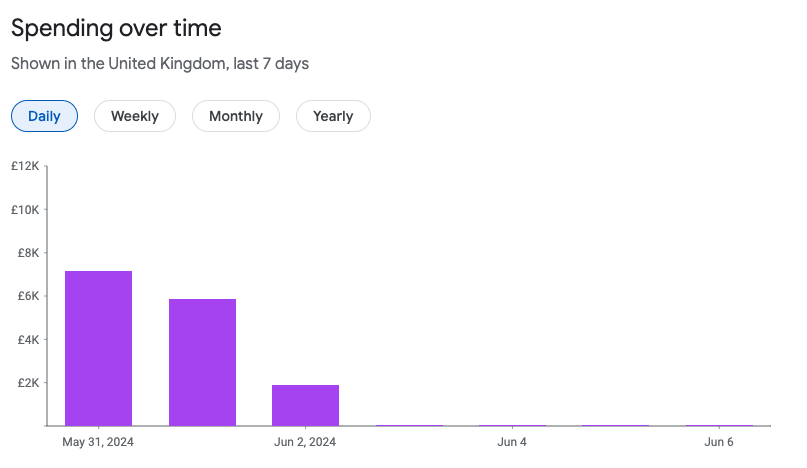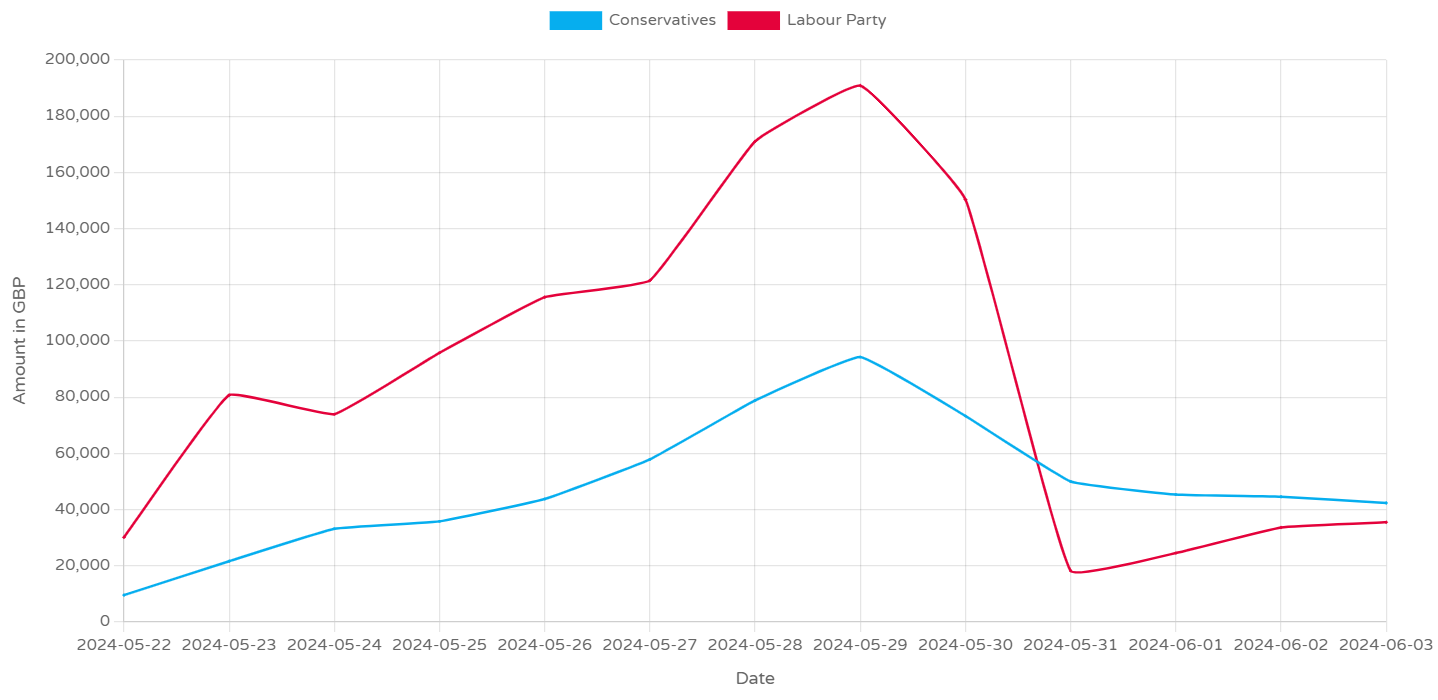The Tory Digital Strategy: Going, going, gone?
The party's approach to digital looks cooked. What's next?
Tuesday night’s debate was meant to be a moment for Rishi Sunak to savour.
Having exceeded expectations and ‘beaten’ Keir Starmer (albeit by a tiny margin in a single poll, which other polls later contradicted), you’d have expected the Conservative campaign to make full use of his best moments in front of the cameras in their digital campaign the next day.
Instead, at least in terms of their paid ads, it’s been virtual silence ever since. While Labour launched ads showing Keir Starmer’s best bits from the debate, the Conservative ad campaigns went quiet, got quieter, then stopped entirely.
At the time of writing, and following Sunak’s self-inflicted D-Day gaffe, every single digital ad on their main pages has been switched off. Currently, the campaign has no active ads on Facebook, Instagram, Google or YouTube.
Most notably, the ad making the claim at the centre of Sunak’s debate ‘victory’ (that Labour would hike taxes by £2,000 over the next parliament) and which many expected would be repeated ad infinitum right up to polling day, stopped too. The Conservatives had spent nearly £40k on it, and by the time of the debate it had already been running for several days and been shown up to 10 million times. It’s now gone like all the rest.
Until this point, the Conservatives had focused their advertising spend on the profile of typical Reform UK voters: mostly men, mostly over 45 years old, with interests in issues like the monarchy, the military, and immigration. This approach was aligned with their stated strategy - an attempt to limit the electoral damage on their right flank.
But following the return of Nigel Farage, both the wider Conservative political strategy - and from our particular perspective the party’s digital marketing strategy - seem to have been blown to bits. Since becoming PM, Rishi Sunak has tried several different angles in an attempt to find something that works. He’s had a go at ‘change’, ‘continuity’, ‘toughness’ and being the man with a plan in an uncertain world. None has shifted the dial. Now the rightward pivot to reclaim Reform voters for the Tories is gone too.
A highly centralised campaign

If the national campaign has been blown off course, perhaps it could be rescued by what’s happening locally? But there the Tory campaign has been very quiet too. While Conservative spending on its main Meta pages has run above Labour’s since the election announcement on 22nd May, once you include local candidate spending, the numbers look very different.
The Tories’ main pages have outspent Labour £447,000 to £331,000 on Meta since May 22nd. But once you include local pages, Labour has outspent the Tories on Meta by £1,147,000 to £638,000.
The parties are clearly taking different approaches. Two-thirds of Labour’s paid digital campaign (so far), has gone through candidates. By contrast, around 70% of Tory ad spending has come from the main party page. This would seem to speak further to the Tories’ lack of preparation for this campaign, with many MPs standing down, changing seats and a large number of late candidate selections taking place.
(Note that the local campaigns taper off as the short campaign spending limits kicked in for them after the dissolution of parliament last week. They’re much more constrained from here on, and we’d expect main party page spending to dominate from here on).
Why might this be happening?
While stopping running campaign ads might appear to be a sign of a campaign in distress, it’s not the only possible cause.
First, varying a campaign’s tempo is perfectly normal. Labour has also slowed their spending compared to the first week of the campaign. Everyone, including voters, needs a break, even in a campaign as short as a British one. The most obvious way for a campaign to do this is to start and finish fast. A week from now, the Conservative and Labour digital campaigns will likely be back in full flow, spending £50-100k+ a day on ads and reaching millions with them. This is a pause, not a stop, and much more is to come.
Second, the Tory focus on national ad spending from the main party page is a choice. It’s one that gives the central campaign a lot of control of message, targeting and pacing. But it means that when you slow down or stop spending from your main accounts, the whole campaign is affected. By contrast, Labour’s approach is riskier, as it allows their candidates to do their own thing and potentially go off-message. So far though, they seem to have that under control.
Finally, the slowdown, then stop, of the paid digital campaign could actually be the result of organisational breakdown and loss of control. Farage’s arrival on the scene makes it very hard to see how the Conservatives can now bring Reform supporters back into the fold, and the D-Day gaffe will make this even harder. The party has already spent hundreds of thousands of pounds on digital ads trying to reach this audience. Continuing to do so would be throwing good money after bad. The arrival of Farage has scrambled their strategy, the polls are going the wrong way and now other things are too. Meetings will be taking place, decisions will need to be made, and in the meantime everything just grinds to a halt.
So what now?
Some difficult decisions lie ahead for Rishi Sunak and Isaac Levido, his campaign director.
There are some milestones left in the campaign, particularly the launch of the party’s manifesto (most likely next week) along with leader interviews and the remaining debates. There’s also the possibility that Labour has a big future campaign gaffe up their sleeve that they can jump on. These sorts of things can act as tactical hooks for the digital campaign, but to benefit from them the Conservatives will need to be more responsive than they’ve been to date. As football managers often say when they’re losing badly at half-time - “let’s win the second half”.
They can also switch towards the overt defence of seats, focusing on the ones they have to hold onto if they’re to stay relevant in the next parliament. We’ve read reports that their internal benchmark is 150 seats - equivalent to over 200 losses. This would suggest there’s a range of seats 25-50 seats either side of those with a 15,000 current Tory majority that will be the focus of campaigning from here on.
Next week, we’ll be launching a constituency map of the UK showing where ads are being targeted. The seats the parties are defending (and attacking) in will show up there. Here’s a sneak preview (before you spend too much time with the magnifying glass, remember that there’s a lot more ad spending to come):
Thanks for reading. More soon!
Team Full Disclosure @ Who Targets Me
Please install WTM’s browser extension to help us monitor all the major parties’ digital campaigns. The next four weeks will help us conduct critical research into the way parties run modern campaigns, as well as into the impact of platforms on elections.
And a reminder that all the charts and data we create are available via trends.whotargets.me.








